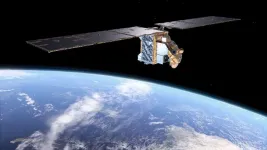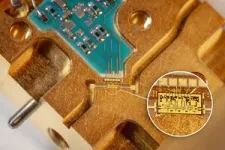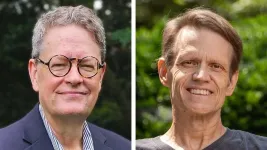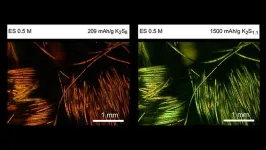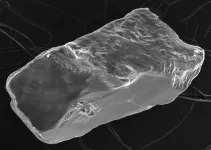(Press-News.org) The Arctic Weather Satellite (AWS) of the European Space Agency (ESA) was sent on its journey to a polar orbit 600 km above the Earth on August 16, 2024. On board: four low-noise amplifiers (LNAs) from the Fraunhofer Institute for Applied Solid State Physics IAF in Freiburg. They are essential components of the passive microwave radiometer with which the AWS measures temperature and humidity in the Arctic more precisely than ever before. This should contribute to a better understanding of both the Arctic and the climate change that is particularly visible in it. If the mission is successful, ESA plans to launch a global constellation of identical small satellites into space to enable more precise and shorter-term weather forecasts (nowcasting) and climate observations on a global scale.
The task of LNAs in technical systems is to improve the quality of incoming signals. As their name suggests, they amplify weak signals while causing as little background noise as possible so that signals can be more easily detected and analyzed. In this way, LNAs increase the sensitivity of systems.
“The more powerful a low-noise amplifier is, the more accurately and reliably a system can collect data. They play a major role in satellite-based Earth observation, as the microwave radiation that reaches the satellite radiometer is very weak,” explains Dr. Fabian Thome, Deputy Head of Business Unit High Frequency Electronics at Fraunhofer IAF. “It is a great confirmation and motivation that we are contributing to better research into the Arctic and its effects on the global climate with our LNAs.”
Fraunhofer IAF contributes LNAs for frequency ranges around 54, 89 and 170 GHz to the AWS radiometer
The AWS microwave radiometer consists of a rotating antenna that picks up the natural microwave radiation emitted by the Earth’s surface and transmits it to four feedhorns and four receivers. The antenna and receiver each belong to one of four groups comprising a total of 19 channels, which together cover a frequency spectrum of 50 to 325 GHz: Eight channels with frequencies from 50 to 58 GHz measure temperature, one channel at 89 GHz detects clouds, another at 165.5 GHz both clouds and humidity, five channels between 176 and 182 GHz are only responsible for humidity, while finally four channels at 325 GHz plus/minus 1.2 to 6.6 GHz measure humidity and also detect clouds. With this technical equipment, the radiometer is able to create high-resolution vertical humidity and temperature profiles under all weather conditions.
Fraunhofer IAF has provided a total of four LNAs for three of the four channel groups: one module for the frequency range around 54 GHz, two identical modules for 89 GHz, which were connected in series for greater overall amplification, and one module for the 170 GHz range. The researchers have enhanced proven technologies based on the compound semiconductor indium gallium arsenide (InGaAs) and realized metamorphic high-electron-mobility transistors (mHEMTs) for monolithic microwave integrated circuits (MMICs).
World-leading InGaAs mHEMT technology for MMICs
“Fraunhofer IAF is a world leader in the development of transistors and circuits for satellite-based radiometry systems. Our modules define the state of the art in many performance areas,” emphasizes Thome. This can also be seen exemplarily in the AWS radiometer modules: In tests, the LNA for the frequency range around 54 GHz achieved a noise figure of 1.0 to 1.2 dB with a gain of 31 to 28 dB, thus significantly improving the state of the art. With noise figures of 1.9–2.3 dB at 23–25 dB gain (89 GHz) and 3.3–4.1 dB at 25–30 dB gain, the other AWS LNAs are exactly in the range of the current state of the art (John et al. 2023).
In developing the modules, the researchers worked closely with the direct client ACC Omnisys (AAC Clyde Space) from Sweden, which built the radiometer system for OHB Sweden and ESA. Fraunhofer IAF was able to use its research infrastructure and the expertise of its employees along the entire value chain in the development and production of the modules: Teams from the fields of microelectronics, epitaxy, technology and precision mechanics worked closely together and carried out all the key steps from circuit design to material growth, processing and measurement as well as process technology, separation, assembly technology through to module construction and integration until the LNA modules were ready for use. An Initial qualification of the modules for use in space also took place at the institute before the hardware was handed over for receiver integration.
AWS and EPS-Sterna: New Space for more precise weather forecasts, nowcasting and climate monitoring
The AWS mission is to collect more precise weather data in the Arctic for the first time, which will enable short-term forecasts for the polar region — including so-called nowcasting, which refers to forecasts for the next few hours. As the Arctic has a strong influence on global weather, the data also enables better global weather forecasts. This also applies to the climate: climate change is progressing faster in the Arctic than in other regions of the world. At the same time, changes in the Arctic have an impact on the global climate due to feedback effects.
If successful, an entire constellation of identical small satellites will follow the AWS: the EUMETSAT Polar System — Sterna (EPS-Sterna). The plan is to have six satellites in three different orbits at the same time to collect long-term weather data from the polar regions. The satellite set will be renewed three times, so that a total of 18 satellites will be used during the time of the mission. Two satellites are planned as replacements. The first of six EPS-Sterna satellites is due to be launched in 2029.
With this project, ESA is pursuing the New Space approach for the first time. New Space is characterized by projects being carried out in the shortest possible time with significantly fewer resources. In the case of AWS, whose total mass is only 150 kg, only three years passed from project start to rocket launch, during which a fraction of the cost was incurred compared to previous projects. Further advantages of New Space are the greater resilience of constellations — the failure of a satellite in the network can be compensated for or replaced quickly and cheaply — and the flexibility of missions, which can be extended or shortened if necessary, without consuming large amounts of resources.
Fraunhofer IAF at EuMW 2024
From September 24 to 26, 2024, Fraunhofer IAF will present exhibits of the LNA modules installed in the AWS radiometer as well as other high-frequency electronics from the application areas of satellite communications, mobile communications or low-temperature measurement technology at this year’s European Microwave Week (EuMW) in Paris (booth: 202K).
Researchers are also represented in the conference program with the following topics:
Sunday, Sept. 22, 8:30–12:20, WS09 EuMC, Room 725–726
Dr. Laurenz John: “THz circuit and front-end developments based on InGaAs-channel mHEMT devices”
Monday, Sept. 23, 8:30 a.m., EuMIC03, Room E04
Dr. Axel Tessmann: “High-Gain 664 GHz Low-Noise Amplifier Modules Based on Advanced InGaAs HEMT Technologies”
Monday, 23.9., 16:50, EuMIC14-3, Room E02
Dr. Philipp Neininger: “mm-Wave GaN Varactors and E-/W-Band Phase Shifter”
On Wednesday, September 25, students and young professionals from the field of microwave technology can also get to know Fraunhofer IAF at the Young Professionals' Career Event, which will take place from 12 to 3 p.m. in Hall 7.3 of the Paris Expo Porte de Versailles. Participation is free of charge. The accompanying Career Party will take place from 7 p.m. at Chalet du Lac (avenue Anna Politovskaïa, 75012 Paris). Tickets will be available at the afternoon event.
Further information
ESA website on AWS
Electronic circuits at Fraunhofer IAF
Fraunhofer IAF at EuMW 2024
Publication Dr. Laurenz John: Low-Noise Amplifiers for the Arctic Weather Satellite
------------------------------------------------------------------------------------------------------
About Fraunhofer IAF
The Fraunhofer Institute for Applied Solid State Physics IAF is one of the world's leading research institutions in the fields of III-V semiconductors and synthetic diamond. Based on these materials, Fraunhofer IAF develops components for future-oriented technologies, such as electronic circuits for innovative communication and mobility solutions, laser systems for real-time spectroscopy, novel hardware components for quantum computing as well as quantum sensors for industrial applications. With its research and development, the Freiburg research institute covers the entire value chain — from materials research, design and processing to modules, systems and demonstrators. www.iaf.fraunhofer.de/en
END
Fraunhofer IAF low-noise amplifiers aboard the Arctic Weather Satellite
Improving weather forecasts and climate monitoring with InGaAs mHEMT technology
2024-09-16
ELSE PRESS RELEASES FROM THIS DATE:
Immunotherapy after surgery helps people with high-risk bladder cancer live cancer-free longer
2024-09-16
Results from a large clinical trial show that treatment with an immunotherapy drug may nearly double the length of time people with high-risk, muscle-invasive bladder cancer are cancer-free following surgical removal of the bladder. Researchers found that postsurgical treatment with pembrolizumab (Keytruda), which is approved by the Food and Drug Administration (FDA) for treating at least 18 different cancers, was superior compared with observation. The study, led by researchers at the National Institutes of Health (NIH), ...
US COVID-19 rates oscillate every six months
2024-09-16
COVID-19 cases in the U.S. have shown unexpected oscillating waves every six months between the southern states and the northern states and, to a lesser degree, from east to west, according to new research published today in Scientific Reports.
Public health scientists from the University of Pittsburgh, University of Ottawa and University of Washington conducted the first detailed analysis to demonstrate and characterize the six-month oscillation of cases across space and time. It provides key information ...
Lower neighborhood opportunity may increase risk for preterm birth
2024-09-16
FOR IMMEDIATE RELEASE
Monday, September 16, 2024
Contact:
Jillian McKoy, jpmckoy@bu.edu
Michael Saunders, msaunder@bu.edu
##
Lower Neighborhood Opportunity May Increase Risk for Preterm Birth
A new study suggests that neighborhoods with fewer educational, health, environmental, and socioeconomic resources may increase one’s risk for preterm birth and contribute to the racial gap in preterm birth in the Commonwealth.
Preterm birth, defined as a live birth before 37 weeks of pregnancy, is the second-leading cause of infant mortality in the United States, and one that disproportionately affects Black and ...
Analysis finds cardiac devices recalled for safety reasons infrequently subjected to premarket or postmarket testing
2024-09-16
Embargoed for release until 5:00 p.m. ET on Monday 16 September 2024
@Annalsofim
Below please find summaries of new articles that will be published in the next issue of Annals of Internal Medicine. The summaries are not intended to substitute for the full articles as a source of information. This information is under strict embargo and by taking it into possession, media representatives are committing to the terms of the embargo not only on their own behalf, but also on behalf of the organization they represent.
----------------------------
1. ...
Trailblazers in plasma turbulence computer simulations win 2024 James Clerk Maxwell Prize
2024-09-16
A pair of physicists with long ties to PPPL are being honored for their foundational work on turbulence in plasma. Understanding why instabilities occur and how to limit them is critical to perfecting fusion as a stable energy source for the electrical grid.
Greg Hammett, a PPPL theoretical and computational principal research physicist, and Bill Dorland, former associate laboratory director for computational sciences and current Lab adviser, have won the 2024 James Clerk Maxwell Prize for Plasma Physics. The American ...
Technology could boost renewable energy storage
2024-09-16
Renewable energy sources like wind and solar are critical to sustaining our planet, but they come with a big challenge: they don't always generate power when it's needed. To make the most of them, we need efficient and affordable ways to store the energy they produce, so we have power even when the wind isn't blowing or the sun isn't shining.
Columbia Engineering material scientists have been focused on developing new kinds of batteries to transform how we store renewable energy. In a new study published September 5 by Nature Communications, the team used K-Na/S batteries that combine inexpensive, readily-found elements -- ...
Introducing SandAI: A tool for scanning sand grains that opens windows into recent time and the deep past
2024-09-16
Stanford researchers have developed an artificial intelligence-based tool – dubbed SandAI – that can reveal the history of quartz sand grains going back hundreds of millions of years. With SandAI, researchers can tell with high accuracy if wind, rivers, waves, or glacial movements shaped and deposited motes of sand.
The tool gives researchers a unique window into the past for geological and archeological studies, especially for eras and environments where few other clues, such as fossils, are preserved ...
Critical crops’ alternative way to succeed in heat and drought
2024-09-16
Scientists have discovered that certain plants can survive stressful, dry conditions by controlling water loss through their leaves without relying on their usual mechanism - tiny pores known as ‘stomata’.
Nonstomatal control of transpiration in maize, sorghum, and proso millet – all C4 crops which are critical for global food security – gives these plants an advantage in maintaining a beneficial microclimate for photosynthesis within their leaves.
This allows the plants to absorb carbon dioxide ...
Students with multiple marginalized identities face barriers to sports participation
2024-09-16
MINNEAPOLIS/ST. PAUL (09/16/2024) — The U.S. Department of Health and Human Services Healthy People 2030 plan sets a national objective to increase youth sports participation from 50% to 63% over the next five years. For adolescents, staying active offers benefits to their overall health and their social and academic lives. However, the number of youths participating in physical activity and sports is on the decline. While participation gaps based on single social identities ...
Purdue deep-learning innovation secures semiconductors against counterfeit chips
2024-09-16
WEST LAFAYETTE, Ind. — Researchers in Purdue University’s College of Engineering have developed a patent-pending optical counterfeit detection method for chips used in semiconductor devices.
The Purdue method is called RAPTOR, or residual attention-based processing of tampered optical responses. It leverages deep learning to identify tampering. It improves upon traditional methods, which face challenges in scalability and discriminating between natural degradation and adversarial tampering.
Alexander Kildishev, professor in the Elmore ...
LAST 30 PRESS RELEASES:
Chronic breathlessness emerging as a hidden strain on hospitals
Paleontologists find first fossil bee nests made inside fossil bones
These fossils were the perfect home for ancient baby bees
Not everyone reads the room the same. A new study examines why.
New research identifies linked energy, immune and vascular changes in ME/CFS
Concurrent frailty + depression likely boost dementia risk in older people
Living in substandard housing linked to kids’ missed schooling and poor grades
Little awareness of medical + psychological complexities of steroid cream withdrawal
Eight in 10 trusts caring for emergency department patients in corridors, finds BMJ investigation
NASA’s Webb telescope finds bizarre atmosphere on a lemon-shaped exoplanet
The gut bacteria that put the brakes on weight gain in mice
Exploring how patients feel about AI transcription
Category ‘6’ tropical cyclone hot spots are growing
Video: Drivers struggle to multitask when using dashboard touch screens, study finds
SLU research shows surge in alcohol-related liver disease driving ‘deaths of despair’
Rising heat reshapes how microbes break down microplastics, new review finds
Roots reveal a hidden carbon pathway in maize plants
Membrane magic: FAMU-FSU researchers repurpose fuel cells membranes for new applications
UN Member States pledge to increase access to diagnosis and inhaled medicines for the 480 million people living with COPD
Combination therapy shows potential to treat pediatric brain cancer ATRT
Study links seabird nesting to shark turf wars in Hawai‘i
Legal sports betting linked to sharp increases in violent crime, study finds
Breakthrough AI from NYUAD speeds up discovery of life-supporting microbes
New Eva Mayr-Stihl Foundation funding initiative boosts research at University of Freiburg on adaptation of forests to global change
The perfect plastic? Plant-based, fully saltwater degradable, zero microplastics
Bias in data may be blocking AI’s potential to combat antibiotic resistance
Article-level metrics would provide more recognition to most researchers than journal-level metrics
Satiety’s little helper: Protein that supports appetite regulating protein identified
UF dives deep into predicting storm damage with computer models
A stormy ocean voyage yields insights on the global carbon cycle
[Press-News.org] Fraunhofer IAF low-noise amplifiers aboard the Arctic Weather SatelliteImproving weather forecasts and climate monitoring with InGaAs mHEMT technology
